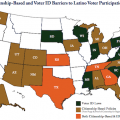
President Obama, accompanied by Senator Debbie Stabenow and Secretary Of Agriculture Tom Vilsack, visited Michigan State University to sign a five-year, $956 billion farm bill into law. The compromise took almost three years to resolve and included $8.6 billion in USDA Supplemental Nutrition Assistance Program (SNAP, or Food Stamps) cuts, funding for agriculture, and support for other initiatives such as incentive programs.
Read Related: From Middle Class to Food Stamps, A Latina Mom’s Tale
The SNAP cuts will disproportionately impact food insecure populations, such as children, seniors, veterans, the working poor, and communities of color. These cuts will hurt those in need as 49 million Americans are food insecure and are living in poverty.
For Latinos and other clients who rely on SNAP to make ends meet, the program cuts will impact their state of food security. Latinos are particularly vulnerable to hunger due to their loss of wealth during the recession. According to the Pew Hispanic Research Center, Latinos have lost 66% of their wealth since 2009, more than any other racial or ethnic group.
As cited by USDA’s Economic Research Service and Feeding America, 23% of Latinos are food insecure while 14% of the general population is food insecure. Latino households are twice as likely as white, non-Hispanic households to lack the food they need for an adequate diet. Moreover, Latinos made up the fastest growing client base at food banks between 2005 and 2009.
Latino children also are at risk as they are three times more likely than the general population to receive emergency food assistance. Similarly, Latino obesity is higher than the national average; 40% of Latino children are overweight or obese, and Latinos are at a greater risk for diabetes as the disease impacts 10% of Latino adults.
If we wish to see food insecurity decline among Latinos, the community must have consistent access to healthy, affordable food through nutrition programs, food banks, local agriculture, and other avenues. Healthy food systems are beneficial for food insecure communities. Ironically, as U.S. Hispanics comprise a $1.2 trillion consumer market, Latino purchasing power increasingly contributes to the economy. The food consumer choices we make at the grocery store, including SNAP purchases, ultimately shape the economy and our health.
Fundamentally, to address Latino hunger in America, we should address the disproportionate impact of poverty in communities of color. The ability to obtain nutritious food is critical for all Americans, including Latinos whose average age is younger than the average age of the general population. The farm bill is a critical legislative mechanism for ensuring food security for Americans, and for providing a means for Latino access to nutrition.
While the SNAP cuts enabled Congress to compromise, the impact on children, mothers, fathers, families, seniors, the working poor, loved ones, and others is a steep price to pay. Perhaps by the next farm bill we will restore full support for our nation’s USDA nutrition assistance programs, and identify more innovative, long-term solutions to strengthen American agriculture and a healthy food system available for all.
Lisa Pino is the former Deputy Administrator of SNAP at USDA and former Deputy Assistant Secretary for Civil Rights at USDA.












